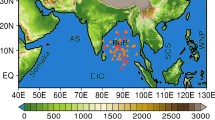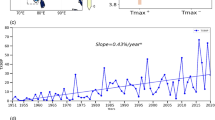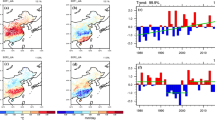Abstract
Event-based extreme precipitation (EEP), defined as an extreme precipitation event (no less than 1 mm for continuous days) having at least one daily precipitation exceeding the 90th percentile, are categorized into three types according to the time distribution pattern (TDP) of extreme precipitation: daily intense precipitation appearing only at the first half of event (TDP1), at both the first and second halves (TDP2), and only at the second half of event (TDP3). This study focuses on the TDP1 and TDP2 types, which occur much more frequently in the central-eastern China and investigates associated distinguishing large-scale teleconnection patterns. The TDP1 events dominantly occur in mid-to-late spring, which are associated with the Silk Road pattern (SRP) wave train manifested from western Europe to northwest Pacific along the subtropical westerly jet. The tripolar sea surface temperature (SST) anomalous pattern over the North Atlantic Ocean, i.e., low SST anomalies in the Azores Islands, two high SST anomalies over the Greenland and subtropical North Atlantic are mainly attributed to force the SRP wave. Meanwhile, the enhanced northwestward moisture transport from the South China converges with the southeastward moisture transport related to the SRP from the North China, resulting in the TDP1 extreme precipitation events over the central-eastern China. The TDP2 events are closely conjunction with the Meiyu precipitation in the Yangtze-Huai River basin in summer. During the TDP2 events, the East Asia/Pacific (EAP) teleconnection is exhibited along the East Asia coasts, which is triggered by the anomalous convection in the western North Pacific. An anomalous anticyclone related to the EAP teleconnection contributes to the westward stretch of the western Pacific subtropical high, providing significant enhanced moisture transportation toward the Yangtze-Huai River basin. Correspondingly, the meridional gradient of the equivalent potential temperature \(\theta_{e}\) is intensified and favored of forming Meiyu front precipitation. This study highlights the definition of EEP event emphasizing the TDP of extreme precipitation and distinguished features of occurring seasons and large-scale circulations associated with the two dominant types of EEP events.










Similar content being viewed by others
References
Bollasina MA, Messori G (2018) On the link between the subseasonal evolution of the North Atlantic Oscillation and East Asian climate. Clim Dyn 51:3537–3557. https://doi.org/10.1007/s00382-018-4095-5
Branstator G (2002) Circumglobal teleconnections, the Jet stream waveguide, and the North Atlantic Oscillation. J Clim 15:1893–1910
Bueh C, Shi N, Ji L, Wei L, Tao S (2008) Features of the EAP events on the medium-range evolution process and the mid- and highlatitude Rossby wave activities during the Meiyu period. Chin Sci Bull 53:610–623
Cao FQ, Gao T, Dan L et al (2019) Synoptic-scale atmospheric circulation anomalies associated with summertime daily precipitation extremes in the middle–lower reaches of the Yangtze River Basin. Clim Dyn. https://doi.org/10.1007/s00382-019-04687-3
Chen GS, Huang RH (2012) Excitation mechanisms of the teleconnection patterns affecting the July precipitation in northwest China. J Clim 25:7834–7851. https://doi.org/10.1175/JCLI-D-11-00684.1
Chen Y, Zhai PM (2015) Synoptic-scale precursors of the East Asia/Pacific teleconnection pattern responsible for persistent extreme precipitation in the Yangtze River valley. Q J R Meteorol Soc 141:1389–1403. https://doi.org/10.1002/qj.2448
Chen MY, Shi W, Xie PP, Silva VBS, Kousky VE, Higgins RW, Janowiak JE (2008) Assessing objective techniques for gauge-based analyses of global daily precipitation. J Geophys Res 113:D04110. https://doi.org/10.1029/2007JD009132
Chen ZH, Yin L, Chen XH, Wei S, Zhu ZH (2015) Research on the characteristics of urban rainstorm pattern in the humid area of Southern China: a case study of Guangzhou City. Int J Clim 35:4370–4386. https://doi.org/10.1002/joc.4294
Cui YF, Duan AM, Liu YM, Wu GX (2015) Interannual variability of the spring atmospheric heat source over the Tibetan Plateau forced by the North Atlantic SSTA. Clim Dyn 45:1617–1634. https://doi.org/10.1007/s00382-014-2417-9
Czaja A, Frankignoul C (2002) Observed impact of Atlantic SST anomalies on the North Atlantic Oscillation. J Clim 15:606–623. https://doi.org/10.1175/1520-0442(2002)015,0606:OIOASA.2.0.CO;2
Ding YH (1992) Summer monsoon rainfalls in China. J Meteorol Soc Jpn 70:397–421
Ding QH, Wang B (2005) Circumglobal teleconnection in the northern hemisphere summer. J Clim 18:3483–3505. https://doi.org/10.1175/jcli3473.1
Enomoto T, Hoskins BJ, Matsuda Y (2003) The formation mechanism of the Bonin high in August. Q J R Meteorol Soc 129:157–178. https://doi.org/10.1256/qj.01.211
Gong D-Y, Gao Y, Guo D, Mao R, Yang J, Hu M, Gao M (2014) Interannual linkage between Arctic/North Atlantic Oscillation and tropical Indian Ocean precipitation during boreal winter. Clim Dyn 42:1007–1027. https://doi.org/10.1007/s00382-013-1681-4
Guan WN, Hu HB, Ren XJ, Yang X-Q (2019) Subseasonal zaonal variability of the western Pacific subtropical high in summer: climate impacts and underlying mechanisms. Clim Dyn. https://doi.org/10.1007/s00382-019-04705-4
Hamidreza MG, Hasan A, Mohammad J (2010) Study of the temporal distribution pattern of rainfall effect on runoff and sediment generation using rain simulator. World Appl Sci J 11:64–69
He SP, Gao YQ, Furevik T, Wang HJ, Li F (2018) Teleconnection between sea ice in the Barents Sea in June and the Silk Road, Pacific-Japan and East Asian rainfall patterns in August. Adv Atmos Sci 35:52–64. https://doi.org/10.1007/s00376-017-7029-y
Hirota N, Takahashi M (2012) A tripolar pattern as an internal mode of the East Asian summer monsoon. Clim Dyn 39:2219–2238
Hitchens N, Brooks H, Schumacher R (2013) Spatial and temporal characteristics of heavy hourly rainfall in the United States. Mon Weather Rev 141:4564–4575. https://doi.org/10.1175/MWR-D-12-00297.1
Hong XW, Lu RY (2016) The meridional displacement of the summer Asian jet, Silk Road pattern, and tropical SST anomalies. J Clim 29:3753–3766. https://doi.org/10.1175/JCLI-D-15-0541.1
Hong W, Ren JX (2013) Persistent heavy rainfall over South China during May–August: subseasonal anomalies of circulation and sea surface temperature. Acta Meteorol Sin 27:6. https://doi.org/10.1007/s13351-013-0607-8
Hong XW, Lu RY, Li SL (2018) Differences in the Silk Road Pattern and Its Relationship to the North Atlantic Oscillation between Early and Late Summers. J Clim 31:9283–9292. https://doi.org/10.1175/JCLI-D-18-0283.1
Hsu H-H, Lin S-M (2007) Asymmetry of the tripole rainfall pattern during the East Asian summer. J Clim 20:4443–4458. https://doi.org/10.1175/jcli4246.1
Huang G (2004) An index measuring the interannual variation of the East Asian summer monsoon—the EAP index. Adv Atmos Sci 21:41–52
Huang RH, Sun FY (1992) Impacts of the tropical western Pacific on the East Asian summer monsoon. J Meteorol Soc Jpn 70:243–256
Huang WY, Yang ZF, He XS, Lin DY, Wang B, Wright JS, Chen RD, Ma WQ, Li FF (2019) A possible mechanism for the occurrence of wintertime extreme precipitation events over South China. Clim Dyn 52:2367–2384. https://doi.org/10.1007/s00382-018-4262-8
Hurrell JW (1995) Decadal trends in the North Atlantic Oscillation: regional temperatures and precipitation. Science 269:676–679
Kalnay E, Kanamitsu M, Kistler R et al (1996) The NCEP/NCAR 40-year reanalysis project. Bull Am Meteorol Soc 77:437–471
Kosaka Y, Nakamura H (2006) Structure and dynamics of the summertime Pacific-Japan teleconnection pattern. Q J R Meteorol Soc 132:2009–2030
Kosaka Y, Nakamura H (2010) Mechanisms of meridional teleconnection observed between a summermonsoon system and a subtropical anticyclone. Part I: the Pacific-Japan pattern. J Clim 23:5085–5108
Kosaka Y, Xie S-P, Nakamura H (2011) Dynamics of interannual variability in summer precipitation over East Asia. J Clim 24:5435–5453. https://doi.org/10.1175/2011jCLI4099.1
Kosaka Y, Chowdary JS, Xie S-P, Min Y, Lee JY (2012) Limitations of seasonal predictability for summer climate over East Asia and the northwestern Pacific. J Clim 25:7574–7589. https://doi.org/10.1175/JCLI-D-12-00009.1
Kurihara K, Tsuyuki T (1987) Development of the barotropic high around Japan and its association with Rossby wave-like propagations over the North-Pacific: analysis of August 1984. J Meteorol Soc Jpn 65:237–246
Lau KM, Weng HY (2002) Recurrent teleconnection patterns linking summertime precipitation precipitation variability over East Asia and North America. J Meteorol Soc Jpn Ser II 80:1309–1324
Li XY, Lu RY (2017) Extratropical factors affecting the variability in summer precipitation over the Yangtze River Basin, China. J Clim 30:8357–8374. https://doi.org/10.1175/jcli-d-16-0282.1
Li J, Wang B (2018) Predictability of summer extreme precipitation days over eastern China. Clim Dyn 51:4543–4554. https://doi.org/10.1007/s00382-017-3848-x
Li CY, Wang J-T, Shi-Z Lin, Cho H-R (2004) The relationship between East Asian summer monsoon activity and northward jump of the upper westerly jet location. Chin J Atmos Sci 28:641–658 (in Chinese)
Li SS, Yang SN, Liu XF (2015) Spatiotemporal variability of extreme precipitation in north and south of the Qinling-Huaihe region and influencing factors during 1960–2013. Prog Geogr 34(3):354–363 (in Chinese)
Liebmann B, Smith CA (1996) Description of a complete (interpolated) outgoing longwave radiation dataset. Bull Am Meteorol Soc 77:1275–1277
Lin ZD (2014) Intercomparison of the impacts of four summer teleconnections over Eurasia on East Asian rainfall. Adv Atmos Sci 31:1366–1376. https://doi.org/10.1007/s00376-014-3171-y
Liu R, Liu SC, Cicerone RJ, Shiu C-J, Li J, Wang JL, Zhang YH (2015) Trends of extreme precipitation in eastern China and their possible causes. Adv Atmos Sci 32:1027–1037
Lu RY, Dong B (2001) Westward extension of North Pacific subtropical high in summer. J Meteorol Soc Jpn 79:1229–1241
Lu RY, Lin ZD (2009) Role of subtropical precipitation anomalies in maintaining the summertime meridional teleconnection over the western North Pacific and East Asia. J Clim 22:2058–2072. https://doi.org/10.1175/2008jcli2444.1
Lu RY, Oh JH, Kim BJ (2002) A teleconnection pattern in upper-level meridional wind over the North African and Eurasian continent in summer. Tellus 54A:44–55. https://doi.org/10.3402/tellusa.v54i1.12122
Mass C, Skalenakis A, Warner M (2011) Extreme precipitation over the west coast of North America: is there a trend? J Hydrometeorol 12(2):310–318
Miao R, Wen M, Zhang RH, Li L (2019) The influence of wave trains in mid-high latitudes on persistent heavy rain during the first rainy season over South China. Clim Dyn 53:2949–2968. https://doi.org/10.1007/s00382-019-04670-y
Nie Y, Ren HL, Zhang Y (2019) The role of extratropical air–sea interaction in the autumn subseasonal variability of the North Atlantic Oscillation. J Clim 32:7697–7712. https://doi.org/10.1175/JCLI-D-19-0060.1
Nitta T (1987) Convective activities in the tropical western Pacific and their impact on the Northern Hemisphere summer circulation. J Meteorol Soc Jpn 65:373–390
Oh H, Ha K-J (2016) Prediction of dominant intraseasonal modes in the East Asian-western North Pacific summer monsoon. Clim Dyn 47:2025–2037. https://doi.org/10.1007/s00382-015-2948-8
Orsolini YJ, Zhang L, Peters DH, Fraedrich K, Zhu XH, Schneidereit A, Hurk B (2015) Extreme precipitation events over north China in August 2010 and their link to eastward-propagating wave-trains across Eurasia: observations and monthly forecasting. Q J R Meteorol Soc 141:3097–3105
Pan L-L (2005) Observed positive feedback between the NAO and the North Atlantic SSTA tripole. Geophys Res Lett 32:L06707. https://doi.org/10.1029/2005GL022427
Pendergrass AG (2018) What precipitation is extreme? Science 360(6393):1072–1073. https://doi.org/10.1126/science.aat1871
Ren XJ, Yang XQ, Sun XG (2013) Zonal oscillation of western Pacific subtropical high and subseasonal SST variations during Yangtze persistent heavy rainfall events. J Clim 26:8929–8946
Ren XJ, Yang DJ, Yang XQ (2015) Characteristics and mechanisms of the subseasonal eastward extension of the South Asian High. J Clim 28:6799–6822. https://doi.org/10.1175/jcli-d-14-00682.1
Reynolds R, Rayner N, Smith TM, Stokes DC, Wang W (2002) An improved in situ and satellite SST analysis for climate. J Clim 15:1609–1625
Saeed S, Lipzig NV, Müller AW, Saeed F, Zanchettin D (2014) Influence of the circumglobal wave-train on European summer precipitation. Clim Dyn 43:503–515. https://doi.org/10.1007/s00382-013-1871-0
Screen JA, Simmonds I (2014) Amplified mid-latitude planetary waves favour particular regional weather extremes. Nature Clim Change 4:704–709. https://doi.org/10.1038/NCLIMATE2271
She DX, Shao QX, Xia J, Taylor JA, Zhang YY, Zhang LP, Zhang X, Zou L (2015) Investigating the variation and non-stationarity in precipitation extremes based on the concept of event-based extreme precipitation. J Hydrol 530:785–798. https://doi.org/10.1016/j.jhydrol.2015.10.029
Sun XG, Greatbatch RJ, Park W, Latif M (2010) Two major modes of variability of the East Asian summer monsoon. Q J R Meteorol Soc 136:829–841. https://doi.org/10.1002/qj.635
Sun XG, Xu YM, Zhang ZQ, Yang X-Q (2019) The tropical and extratropical-origin summer meridional teleconnections over East Asia. Clim Dyn. https://doi.org/10.1007/s00382-018-04610-2
Sung M-K, Kwon W-T, Baek H-J, Boo K-O, Lim G-H, Kug J-S (2006) A possible impact of the North Atlantic Oscillation on the East Asian summer monsoon precipitation. Geophys Res Lett 33:L21713. https://doi.org/10.1029/2006gL027253
Takaya K, Nakamura H (2001) A formulation of a phase-independent wave-activity flux for stationary and migratory quasi-geostrophic eddies on a zonally varying basic flow. J Atmos Sci 58(6):608–627. https://doi.org/10.1175/1520-0469(2001)058%3C0608
Tao L, Li T, Ke Y-H, Zhao J-W (2017) Causes of interannual and interdecadal variations of the summertime Pacific-Japan-like pattern over East Asia. J Clim 30:8845–8864. https://doi.org/10.1175/JCLI-D-15-0817.1
Wakabayashi S, Kawamura R (2004) Extraction of major teleconnection patterns possibly associated with anomalous summer climate in Japan. J Meteorol Soc Jpn 82:1577–1588
Wang N, Zhang Y (2015) Connections between the Eurasian teleconnection and concurrent variation of upper-level jets over East Asia. Adv Atmos Sci 32:336–348
Wang MR, Wang J, Duan AM, Liu YM, Zhou SW (2018) Coupling of the quasi-biweekly oscillation of the Tibetan Plateau summer monsoon with the Arctic Oscillation. Geophys Res Lett 45:7756–7764. https://doi.org/10.1029/2018GL077136
Watanabe M (2004) Asian jet waveguide and a downstream extension of the North Atlantic Oscillation. J Clim 17:4674–4691
Watanabe T, Yamazaki K (2014) The upper-level circulation anomaly over central Asia and its relationship to the Asian monsoon and mid-latitude wave train in early summer. Clim Dyn 42:2477–2489. https://doi.org/10.1007/s00382-013-1888-4
Watanabe M, Kimoto M, Nitta T (1999) A comparison of decadal climate oscillations in the North Atlantic detected in observations and a coupled GCM. J Clim 12:2920–2940
Weng HY, Sumi A, Takayabu YN, Kimoto M, Li CY (2004) Interannual–interdecadal variation in large-scale atmospheric circulation and extremely wet and dry summers in China/Japan during 1951–2000. Part I: spatial patterns. J Meteorol Soc Jpn Ser II 82:775–788
White RH, Battisti DS, Skok G (2017) Tracking precipitation events in time and space in gridded observational data. Geophys Res Lett. https://doi.org/10.1002/2017GL074011
Wu Z, Wang B, Li J, Jin F-F (2009) An empirical seasonal prediction model of the east Asian summer monsoon using ENSO and NAO. J Geophys Res Atmos 114:D18120. https://doi.org/10.1029/2009jd011733
Wu XS, Guo SL, Yin JB, Yang G, Zhong YX, Liu DD (2018) On the event-based extreme precipitation across China: time distribution, trends and return levels. J Hydrol 562:305–417. https://doi.org/10.1016/j.jhydrol.2018.05.028
Xie PP, Yatagai A, Chen MY, Hayasaka T, Fukushima Y, Liu CM, Yang S (2007) A gauge-based analysis of daily precipitation over East Asia. J Hydrometeorol 8:607–627. https://doi.org/10.1175/JHM583.1
Yang J, Bao Q, Wang B, Gong D, He H, Gao M (2013) Distinct quasi-biweekly features of the subtropical East Asian monsoon during early and late summers. Clim Dyn 42:1469–1486
Yasui S, Watanabe M (2010) Forcing processes of the summertime circumglobal teleconnection pattern in a dry AGCM. J Clim 23:2093–2114. https://doi.org/10.1175/2009JCLI3323.1
Yu L, Weller RA (2007) Objectively analyzed air–sea heat fluxes for the global ice-free oceans (1981–2005). Bull Am Meteorol Soc 88:527–540. https://doi.org/10.1175/BAMS-88-4-527
Zhang YC, Wang DQ, Ren XJ (2008) Seasonal variation of the meridional wind in temperate jet stream and its relationship to the Asian monsoon. Acta Meteorol Sin 66(5):707–715 (in Chinese)
Zhang Q, Singh V, Peng J, Chen YD, Li J (2012) Spatial-temporal changes of precipitation structure across the Pearl River basin, China. J Hydrol 440:113–122
Zhi X, Zhang L, Pan JL (2010) An analysis of the winter extreme precipitation events on the background of climate warming in Southern China. J Trop Meteorol 16(4):325–332
Zhou Y, Gao S, Shen SSP (2004) A diagnostic study of formation and structures of the Meiyu front system over East Asia. J Meteorol Soc Jpn 82:1565–1576. https://doi.org/10.2151/jmsj.82.1565
Zuluaga M, Houze J (2015) Extreme convection of the near-equatorial Americas, Africa, and Adjoining Oceans as seen by TRMM. Mon Weather Rev 143:298–316. https://doi.org/10.1175/MWR-D-14-00109.1
Zuo JQ, Li WJ, Sun CH, Xu L, Ren HL (2013) Impact of the North Atlantic sea surface temperature tripole on the East Asian summer monsoon. Adv Atmos Sci 30(4):1173–1186. https://doi.org/10.1007/s00376-012-2125-5
Acknowledgements
This study was supported by the National Key R&D Program of China (Grant no. 2018YFC1505903) and the National Natural Science Foundation of China (Grant nos. 41701592 and 41771030). The daily precipitation data was supplied from the CMA at http://data.cma.cn/. The NCEP/NCAR reanalysis data was provided by http://www.esrl.noaa.gov/psd/data/gridded/data.necp.reanalysis.html.
Author information
Authors and Affiliations
Corresponding author
Additional information
Publisher's Note
Springer Nature remains neutral with regard to jurisdictional claims in published maps and institutional affiliations.
Rights and permissions
About this article
Cite this article
Shang, W., Li, S., Ren, X. et al. Event-based extreme precipitation in Central-Eastern China: large-scale anomalies and teleconnections. Clim Dyn 54, 2347–2360 (2020). https://doi.org/10.1007/s00382-019-05116-1
Received:
Accepted:
Published:
Issue Date:
DOI: https://doi.org/10.1007/s00382-019-05116-1




